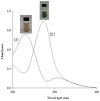Evaluation of the toxic potential of graphene copper nanocomposite (GCNC) in the third instar larvae of transgenic Drosophila melanogaster (hsp70-lacZ)Bg(9.)
- PMID: 24339891
- PMCID: PMC3855226
- DOI: 10.1371/journal.pone.0080944
Evaluation of the toxic potential of graphene copper nanocomposite (GCNC) in the third instar larvae of transgenic Drosophila melanogaster (hsp70-lacZ)Bg(9.)
Erratum in
- PLoS One. 2014;9(3):e93127
Abstract
Graphene, a two-dimensional carbon sheet with single-atom thickness, have attracted the scientific world for its potential applications in various field including the biomedical areas. In the present study the graphene copper nanocomposite (GCNC) was synthesized, characterized and evaluated for its toxic potential on third instar larvae of transgenic Drosophila melanogaster (hsp70-lacZ)Bg(9) . The synthesized GCNC was analyzed by X-ray diffraction (XRD), scanning/transmission electron microscopy (SEM/TEM), atomic force microscopy (AFM), and fourier transform infrared spectroscopy (FTIR). The GCNC in 0.1% DMSO was sonicated for 10 min and the final concentration of 0.033, 0.099, 0.199 and 3.996 µg/µl of diet were established. The third instar larvae were allowed to feed on it separately for 24 and 48 hrs. The hsp70 expression was measured by O-nitrophenyl-β-D-galactopyranoside assay, tissue damage by trypan blue exclusion test and β-galactosidase activity was monitored by in situ histochemical β-galactosidase staining. Oxidative stress was monitored by performing lipid peroxidation assay and total protein estimation. Ethidium bromide/acridine orange staining was performed on midgut cells for apoptotic index and the comet assay was performed for the DNA damage. The results of the present study showed that the exposure of 0.199 and 3.996 µg/µl of GCNC were toxic for 24 hr of exposure and for 48 hr of exposure: 0.099, 0.199 and 3.996 µg/µl of GCNC was toxic. The dose of 0.033 µg/µl of GCNC showed no toxic effects on its exposure to the third instar larvae for 24 hr as well as 48 hrs. This dose can be considered as No Observed Adverse Effect Level (NOAEL).
Conflict of interest statement
Figures












References
-
- Chang Y, Yang ST, Liu JH, Dong E, Wang Y, et al. (2011) Invitro toxicity evaluation of graphene oxide on A549 cells. Toxicology Letters 200: 201–210. - PubMed
-
- Pumera M (2009) Electrochemistry of graphene: new horizons for sensing and energy storage. The Chemical Record 9: 211–23. - PubMed
-
- Cao A, Liu Z, Chu S, Wu M, Ye Z, et al. (2010) A Facile One-step Method to Produce Graphene–CdS Quantum Dot Nanocomposites as Promising Optoelectronic Materials. Advanced Materials 22: 103–106. - PubMed
MeSH terms
Substances
LinkOut - more resources
Full Text Sources
Other Literature Sources
Molecular Biology Databases
Miscellaneous

